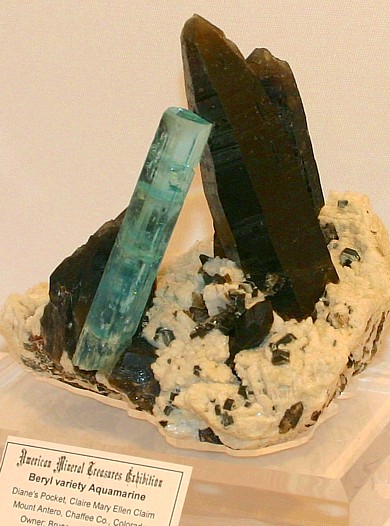|
.
Aquamarine (Beryl) Mineral Facts:
Chemical Formula: Be2Al22(SiO3)6
A trace of water is included.
Colors:
Aquamarine is the
Blue to blue-green variety of this gemstone. It is colored by ferrous
iron. Beryl can be colorless or of some light
shade of green, red, or blue. Its streak is white.
Hardness:
7.5 to 8.0
Hardness varies somewhat depending
on formation and impurities.
Density: 2.6
to 2.8
Cleavage:
Beryl's
cleavage is very imperfect but there is frequently a parting parallel to
the base.
Crystallography: Hexagonal
Strong
prismatic habit. The
usual form is in sharp and,
in some cases, very large columnar crystals with a distinct hexagonal
habit.
Aquamarine is normally found in crystals elongated on the "C" axis.
Crystals are frequently vertically striated and grooved. Forms usually
present consist only of prism of first order and base. Crystals can be
of considerable size with rough faces.
Luster:.
Beryl has a glassy
luster. It is transparent or translucent. Aquamarine is the name
given to the pale greenish blue transparent stone. Used as a gem or as a
collectors stone.
Optics:
(Refractive Index):
w= 1.5740, e= 1.5690
Pleochroism
is noticeable in green (emerald) and blue (aquamarine) crystals.
|
 |
|
Composition,
Structure and Associated Minerals:
Beryl is a frequent constituent
of coarse-grained granites. It is important as a gem material, and is
particularly interesting because of the many physical investigations that
have been made with the aid of its crystals. Although the mineral is
essentially a beryllium alumino-metasilicate, it usually contains also a
little Fe2O3
and MgO, in many
cases small quantities of the alkalies, and in some
cases also caesium. The mineral occurs as an accessory constituent in
pegmatites and granites, in crystalline schists, especially mica schists and
gneisses, in ore veins and sometimes in clay slates and bituminous
limestones.
Uses. The impure varieties are used
as an important ore of the Space-age metal Beryllium. The transparent
varieties are utilized as gems, under the following names:
Emerald is a deep green variety, the color is
due to Chromium or Vanadium.
Aquamarine, a blue-green variety, colored by
iron.
Golden beryl, a golden yellow-colored variety,
Morganite, a pink, high cesium variety, and
Goshenite or White beryl, a colorless variety.
Identification and Diagnostics
Beryl
whitens and fuses
with difficulty at 5-5.5 to an enamel. Yields a little water on intense
ignition. Insoluble in acids. Recognized usually by its hexagonal crystals,
its hardness, color, etc. Beryl is distinguished from apatite, which it much
resembles, by its greater hardness.
Occurrence,
Localities and Origins (For Aquamarine):
Beryl of the
blue to blue-green aquamarine color is much more common than emerald, and is
found in gem quality in Brazil, Siberia, East Africa and in small amounts
from many other countries. Brazil, however, is by far the most important
producer, and has been the most important producer for more than a century.
Many mines in the Brazilian state of Minas Gerias produce fine aquamarine
crystals. In the United States Aquamarine has been found in various places
in Maine, New Hampshire, Massachusetts, Connecticut, North Carolina,
Colorado, and California, etc. For many decades gem cutters have heated
greenish Aquamarine to drive off the yellow tone and leave a purer blue
color. The color change is stable. Some however, prefer the blue-green
tones. Attractive crystals are popular with mineral collectors.
Return to the
Mineral Collectors Information Page |

Aquamarine Crystal, Brazil |
|


